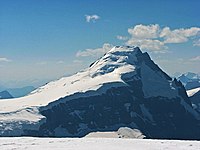List of highest points of Canadian provinces and territories
This is a list of the highest points of the Canadian provinces and territories, by height.
- Notes
- ^A Fairweather Mountain is the officially gazetted name, but Mount Fairweather is the common usage. Mount Fairweather is on the boundary with Alaska, with only the summit and about 1/3 of the peak's massif within British Columbia. The highest summit completely within British Columbia is Mount Waddington (4,019 m (13,186 ft),[14] 51°22′25″N 125°15′48″W / 51.37361°N 125.26333°W[15]) in the Pacific Ranges of the Coast Mountains.
- ^B Because it is on the Continental Divide of the Americas, Mount Columbia is in British Columbia as well as Alberta.
- ^C Nirvana is the unofficial name of this mountain and shows on alpine literature as such, as of 2008[update] the Canadian Government still refers to it as "unnamed peak".
- ^D This peak, which lies on the border between the two provinces, is known as Mount Caubvick in Newfoundland and Labrador and Mont D'Iberville in Quebec. The summit of the mountain is entirely within Labrador, about 10 m (33 ft) from the provincial border.
- ^E The main peak of Maple Mountain has a higher vertical rise over the surrounding landscape, 37 m (121 ft) higher than the Ishpatina Ridge rising over Scarecrow Lake.
Lowest points
[edit]Since there is no land area of Canada that is below sea level,[1] the lowest elevation of Canada is at any point along its maritime coast, and all provinces and territories except Alberta and Saskatchewan have a maritime coast. The shore of Lake Athabasca, which straddles Alberta and Saskatchewan, is Saskatchewan's lowest dry point (213 m (699 ft) above sea level). The Slave River (which drains Lake Athabasca) flows from northeastern Alberta into the Northwest Territories and is Alberta's lowest point at the N.W.T. border (152 m (499 ft) above sea level). However, the False Creek Tunnel, part of the Canada Line rail-based transit system in Vancouver, at 29 m (95 ft) below sea level, is the lowest publicly accessible point in Canada.[16] Parts of Richmond, British Columbia are below sea-level, though behind dikes.[citation needed]
References
[edit]- ^ a b c "Highest Points by Province and Territory". Archived from the original on 7 May 2006. at the Atlas of Canada
- ^ "Mount Logan". Geographical Names Data Base. Natural Resources Canada.
- ^ "Fairweather Mountain". Geographical Names Data Base. Natural Resources Canada.
- ^ "Mount Columbia". Geographical Names Data Base. Natural Resources Canada.
- ^ "Yukon, Northwest Territories and Nunavut Ultra-Prominences". Peaklist.org. Retrieved 14 August 2022.
- ^ "Barbeau Peak". Geographical Names Data Base. Natural Resources Canada.
- ^ "Mount Caubvick". Geographical Names Data Base. Natural Resources Canada.
- ^ "Mont D'Iberville". Geographical Names Data Base. Natural Resources Canada.
- ^ "Cypress Hills". Geographical Names Data Base. Natural Resources Canada.
- ^ "Baldy Mountain". Geographical Names Data Base. Natural Resources Canada.
- ^ "Mount Carleton". Geographical Names Data Base. Natural Resources Canada.
- ^ "Ishpatina Ridge". Geographical Names Data Base. Natural Resources Canada.
- ^ "White Hill". Geographical Names Data Base. Natural Resources Canada.
- ^ "Principal heights by range or region". Archived from the original on 3 August 2003.
- ^ "Mount Waddington". Geographical Names Data Base. Natural Resources Canada.
- ^ "Frequently Asked Questions About Canada". Archived from the original on 4 June 2006. Retrieved 7 September 2008.









